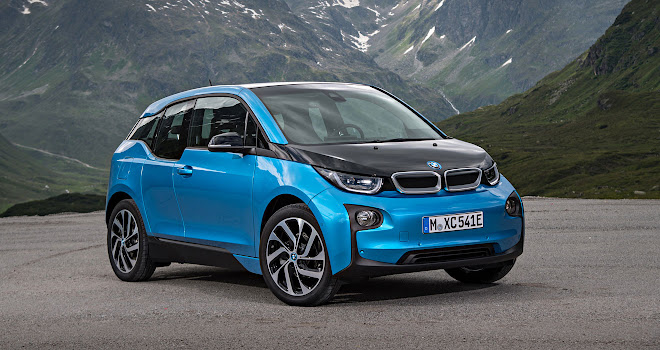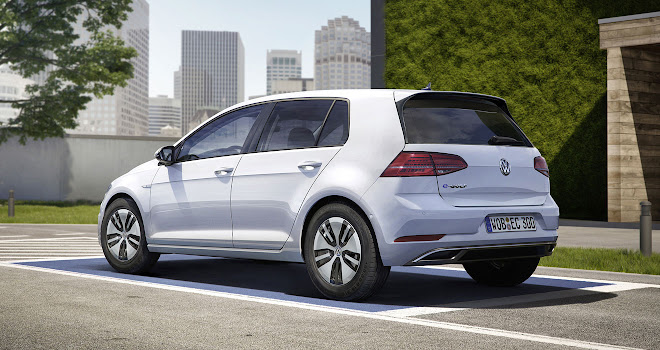Tesla is still the reigning champion when it comes to providing long-distance pure electric cars, with its top of the range 100kWh battery pack giving the Model S saloon a range of 409 miles between recharges according to official tests, or a reliable 300 miles in real-world conditions.
While most other EVs can’t get close to that level of capability, other manufacturers have been raising their game over the past year, with battery upgrades launched or announced for the Nissan Leaf, BMW i3, Renault Zoe and Volkswagen e-Golf.
30kWh Nissan Leaf

From February 2016 Nissan’s popular Leaf electric car became available with a larger 30kWh battery – offering a 25% increase over the original 24kWh power pack. Improvements in battery technology allowed Nissan to squeeze the extra capacity into the same space as before, with only a modest 21kg increase in weight.
The bigger battery boosts the Leaf’s official NEDC range capability from 124 miles to 155 miles. While Nissan doesn’t appear to give buyers any concrete guidance on achievable range in the real world, careful drivers can expect a little under 100 miles from the 24kWh battery in mild weather, and about 125 miles with the larger one.
Like all EVs, the Leaf will not manage to travel quite as far with either the heater of the aircon blowing.

The smaller battery remains available alongside the bigger one, and offers a reasonable cost saving of £1,600 for buyers who don’t envisage taking their Leaf on any longer trips.
Whichever battery buyers choose they can purchase the Leaf outright or opt to pay £5,000 less upfront and agree to a monthly battery rental plan.
Leasing the battery costs from £70 per month to £113 per month, depending on the agreed annual mileage and the duration of the rental contract.

The entry level 24kWh Leaf starts at £16,680 with battery leasing, after the Plug-in Car Grant. Prices start at £20,380 for the 30kWh Leaf, which is only available in the mid-level Acenta trim or above.
Every Leaf features a rapid charging port under its nose flap, allowing an 80% charge in about 30 minutes using the high-power equipment found at Nissan dealers and at motorway services. A 6.6kW on-board charger is an option, allowing the 30kWh Leaf to be fully replenished in about five and a half hours from a domestic wallbox.
When it comes to buying used, it’s important to clarify whether the vehicle includes a leased or purchased battery – the arrangement is fixed for the life of the car and it can be tough to tell which is which from listings even on Nissan’s own used car website. If a Leaf looks temptingly cheap, don’t forget to budget for the fixed monthly fee.
33kWh BMW i3

From July 2016 the innovative carbon-bodied BMW i3 electric car became available with a bigger lithium-ion battery. Capacity went up from around 20kWh to 33kWh. You’ll generally see this increase in capacity referred to as a boost from 60Ah to 94Ah, because BMW happens to prefer battery sizes quoted in amp-hours rather than kilowatt-hours.
The resulting official NEDC range is about 190 miles, but BMW advises 125 miles is nearer the mark in real life. The older 60Ah version had an official rating of 118 miles and a real world capability of 80 to 100 miles, according to BMW.

Prices start at £27,830 after the Plug-in Car Grant. Those wanting long range capability can also opt for the i3 Rex, which has a small engine mounted under the boot floor for generating fresh electricity when the battery runs low. It costs from £30,980 after the grant.
DC rapid charging is fitted as standard to 94Ah cars allowing an 80% charge in about 40 minutes from the high-power chargers found at motorway services. A full charge at home takes under four hours with a 7.4kW BMW-supplied wallbox.

The earliest 60Ah i3s, registered from November 2013, now cost under £14,000 through the BMW approved used scheme. You can also find a few i3 models starting to crop up among the 3- and 5-Series saloons in those car supermarkets that specialise in ex-company cars – I found a two-year-old top-spec i3 listed for £16,590.
41kWh Renault Zoe

An upgraded Renault Zoe electric car with a 41kWh battery will arrive in showrooms from January – offering nearly twice the energy capacity of the 22kWh original battery without any detriment to performance in other areas, such as acceleration.
The bigger battery has an official 250 mile range, but Renault advises that the real world range will vary between 124 and 186 miles. Cars fitted with the smaller battery will manage between 62 and 106 miles before requiring a recharge.
Zoe buyers will also need to decide between buying the car outright or opting for a monthly payment to cover battery rental.

Another complicating factor is the charger rating. Renault sells an R model that supports rapid charging up to 22kW, or a Q model that can be quick charged at up to 43kW using high-power charging points found at motorway services. Counter intuitively, the Q model that supports the quickest top ups takes an hour longer to charge at home using a 7kW wallbox.
A full recharge at home will take 4 hours for the small battery and up to 8 hours and 25 minutes for the bigger battery in a Q spec car.

The earliest Zoe models from 2013 are all battery-rental – Renault didn’t offer outright purchase as an option until late 2014. The oldest models available through the franchised dealer network are now around the £5,000 mark.
Bought new, on the road prices now vary from £13,995 for the most basic Zoe with battery rental and the 22kWh battery, to £26,245 to buy the top-spec model outright with quick charging and the bigger battery. Prices include the Plug-in Car Grant.
Battery rental is £10 per month more expensive with the larger battery. There are six different options running from £59 per month for up to 4,500 miles annually, to £110 per month for unlimited mileage.
36kWh Volkswagen e-Golf

The seventh-generation VW Golf has just undergone a mid-life facelift, and as ever you’ll need to look twice or three times to tell when the updated versions appear early in 2017.
The fully electric e-Golf will also receive some attention, gaining a battery boost from 24.2kWh to 35.8kWh. The official NEDC range estimate with the bigger battery becomes 186 miles, up from 118 miles. Real world range for the updated electric Golf is likely to be around 125 miles in mild weather, when driven with a little care.
The new battery is heavier, so the electric motor has been beefed up by 15kW to 100kW (134bhp) to compensate. VW hasn’t yet revealed how much weight has been added.

The new battery can be charged to 80% capacity “within an hour”, VW says, with support for CCS direct current rapid charging at 40kW. When charged from a standard 7kW domestic wallbox a full charge takes about six hours.
Along with the rest of the revamped range, the new e-Golf will get a larger central touchscreen supporting gesture control, plus full LED lamps front and rear. VW hasn’t yet said exactly when the updated e-Golf will arrive or what it will cost. The current e-Golf, with the 24kWh battery, costs £27,180 after the Plug-in Car Grant.
A six-month old e-Golf can currently be bought through the VW approved used scheme for about £20,500, though prices do seem to vary from dealer to dealer more than you’d expect for a conventional car.





